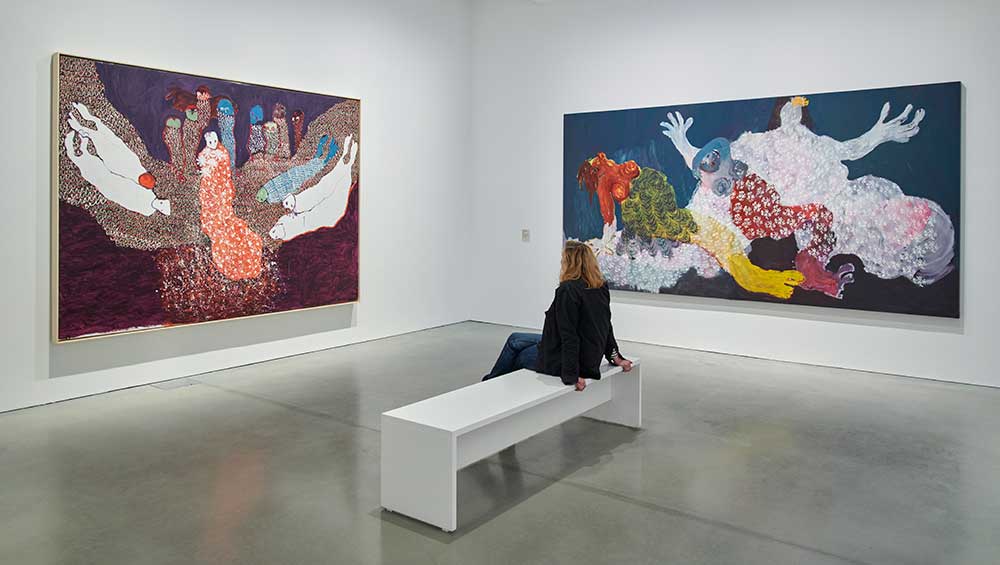
Installation view, Portia Zvavahera: Zvakazarurwa, Kettle’s Yard, Cambridge, 22 October 2024 – 16 February 2025. Photo: Jo Underhill.
Kettle’s Yard, Cambridge
22 October 2024 – 16 February 2025
by BETH WILLIAMSON
Portia Zvavahera’s approach to image-making is unlike anything I have encountered previously. Quite apart from the fact that this is the artist’s first solo exhibition in a public gallery in Europe, her methods and materials are unique. Drawing on the bedrock of her Shona culture and Christian faith, Zvavahera’s layering of method, meaning and material further delves into her personal experience and dreams. Zvakazarurwa is the Shona word for revelation, which not only sits well with Zvavahera’s Christian faith, but gives a concise one-word description of how she experiences dreaming and painting, one undoing and revealing the other, working laboriously through the real and imagined, to come to some sort of resolution of ideas in the powerful images she creates.
Driven by dream-worlds so vivid that they breach the unconscious, Zvavahera draws on stories from her sleeping and waking life that weave together so tightly they are indistinguishable one from another. These are autobiographical paintings – the artist’s proxy appears with a gathering of other figures representing family members, as well as hybrid animal creatures and apparitions. Further, Zvavahera looks to the spiritual and metaphysical traditions she grew up with in Harare, Zimbabwe, where she lives and works.
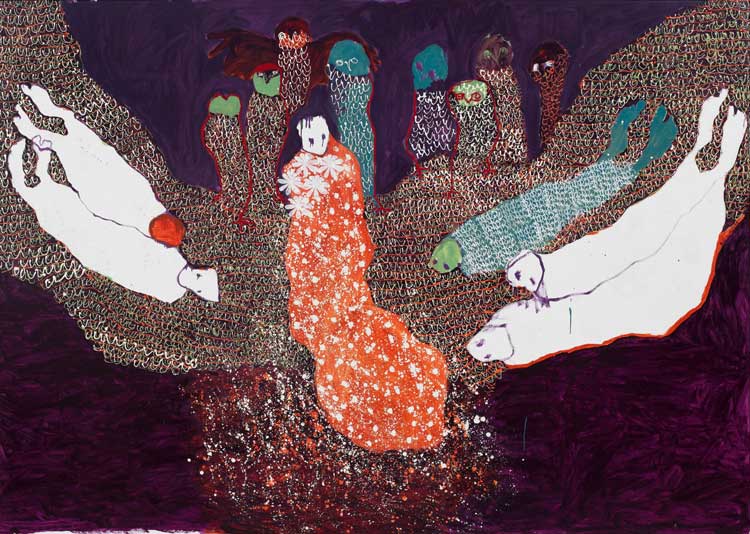
Portia Zvavahera. Kudonhedzwa kwevanhu (Fallen People), 2022. Oil-based printing ink and oil bar on canvas, 212.5 x 299.6 cm. Courtesy Stevenson and David Zwirner. Photo: Mario Todeschini.
Zvavahera’s dreams, it seems, create an archive of affect that it is necessary for her to work through. As she understands it, God speaks through her dreams. Her job as an artist is to work with this covert and complex form of communication. Yet, the images are not in any respect illustrative. Instead, there is a dialogical process between painting and dreaming that creates communicative conduits between conscious and unconscious, between painting and prayer.
The exhibition’s curator, Tamar Garb, calls this the “poetics of revelation”, a poetics that has been mediated and materialised in a particular time and place. In 2017, the artist commented: “I’m always thinking in Shona. Even as I am speaking right now, I’m thinking in Shona. The English titles come because people want to understand what I mean. I dream in Shona and everything is Shona.” That particularity is important.
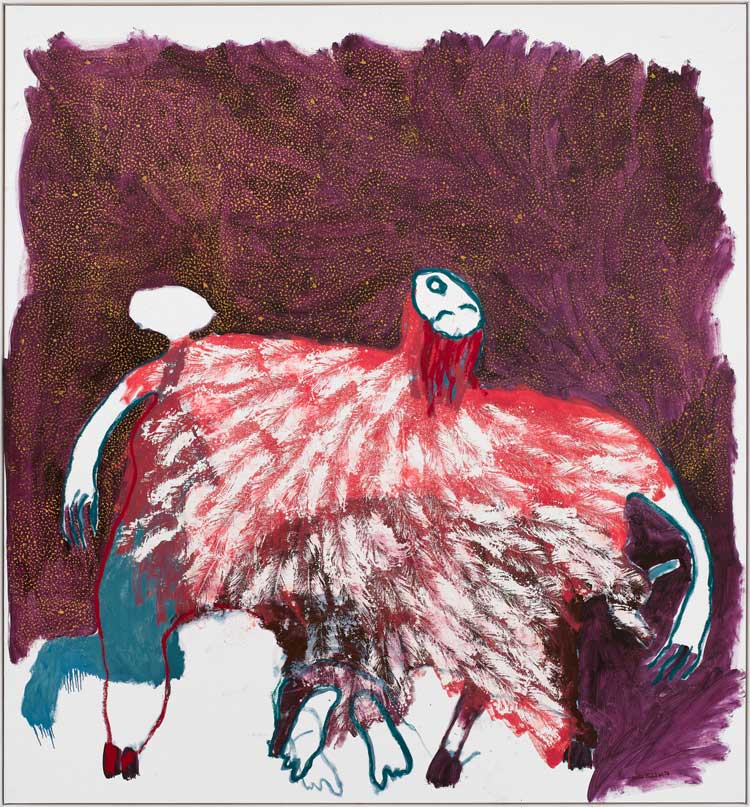
Portia Zvavahera. Fighting Energies 2, 2024. Oil based printing ink and oil bar on linen, 228.4 x 212 cm. Courtesy Stevenson and David Zwirner. Photo: Jack Hems.
Everything may be Shona, but Zvavahera’s education in Zimbabwe was essentially a colonial one so that Shona language and culture become entwined with that in myriad ways. Add to that the place of the evangelical Pentecostal church in her life and the domestic life learned from her mother and grandmother. This rich layering and intertwining of culture, language and faith is mediated through Zvavahera’s material approach, one that engages with painting and printing, often in a single image, and draws on African traditions as well as European ones. Painting with oil-based printing ink, drawing with oil bar, block printing with cardboard or lino, and African wax print batik methods, variously come together in different combinations, unified by pattern and repetition, veiled and shadowed to hide or protect. Garb describes this as “an irreverent confection of methods”. Working in multiple registers at once, often in rich plush pinks, purples, reds and blues, Zvavahera always leaves space on the canvas for a presence, God, to enter into the picture.
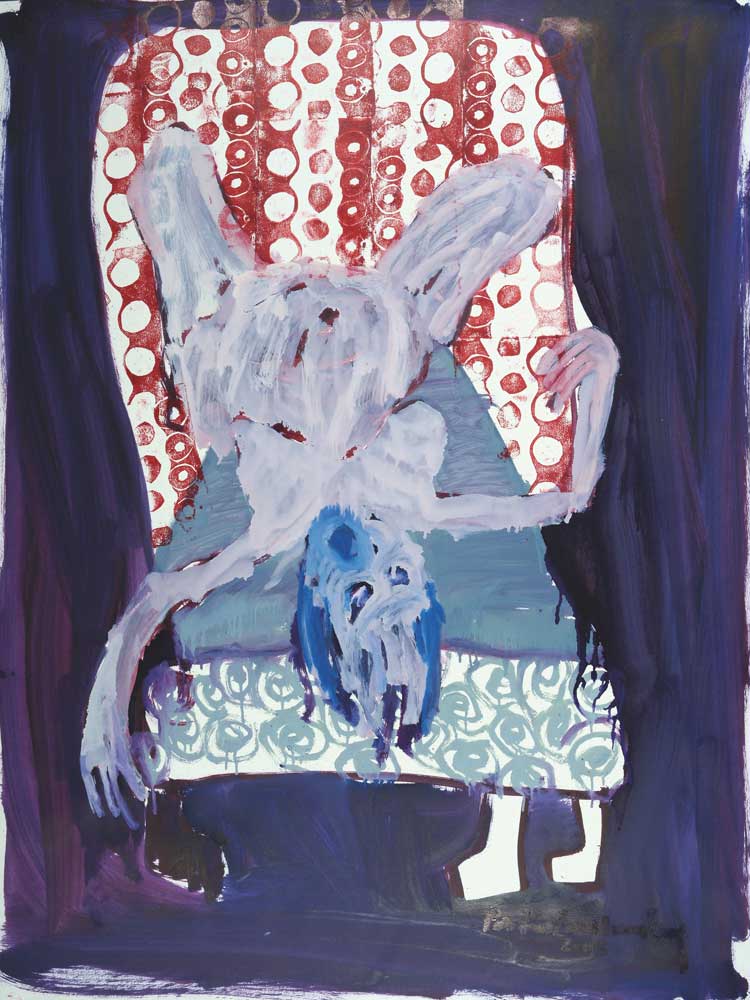
Portia Zvavahera. Labour Pains, 2012. Oil-based printing ink on paper, 100 x 75 cm. Courtesy Stevenson and David Zwirner. Photo: Mario Todeschini.
The concoction of methods comes, at least in part, from Zvavahera’s art education. BAT Visual Art Studios in Harare was initially established in the 1950s by director and teacher Frank McEwen whose pedagogic approach charted a path between “European formal experimentation and a commitment to what was understood as an African derived and autochthonous creativity and consciousness”. Zvavahera attended between 2003 and 2004, and it was in this environment that she began to cultivate her own unique approach. Further developments were to come when she enrolled at Harare Polytechnic in 2005 under the tutelage of painter and activist Charles Kamangwana. It was here that students were encouraged to experiment in different ways, including the use of multiple mediums in a single artwork.
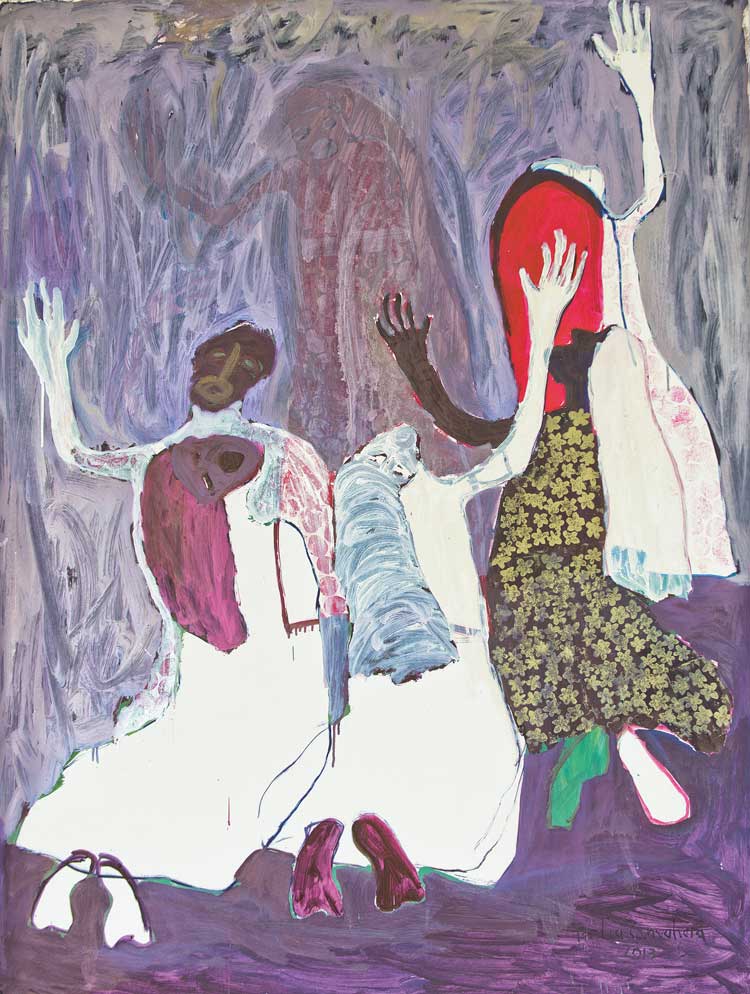
Portia Zvavahera. His Presence, 2013. Oil-based printing ink on paper, 150 x 114 cm. Courtesy of Stevenson and David Zwirner.
The work in this exhibition shows traces of all these influences. There is a clear trajectory from early images to new and more recent work. The earliest works in the exhibition are from 2012. Labour Pains and Labour Ward, both from that year, relate to the artist’s experience of childbirth and are painted using printing ink, without any further layers or techniques to obfuscate the scene. There are elements of pattern and repetition on the mattresses and bedding, but the focus is squarely on the pregnant figure(s), big-bellied and naked, mouths agape in pain, bodies writhing in agony. There is little room for anything else. In His Presence (2013), and Ndahwarara and Ndokumbirawo Ishe, both from 2014, the same material techniques have been used with overtly religious subjects. Now, figures appear prostrate, covering their face, as if in shame, or kneeling with raised arms, as if pleading in agony or ecstasy. The soles of the feet painted parallel to the picture plane act as an unusual point of contact with the viewer. Move forward a few years and works such as Embraced and Protected in You (2016) and I Want to Stay in Love (2017) demonstrate a more complex material engagement with the addition of oil bar, as well as more expansive patterning. In Embraced and Protected in You we see the addition of veils of block printing, as is also the case in Vachengeti Vangu (My Guardian) (2020), where elements of wax resist are also employed.
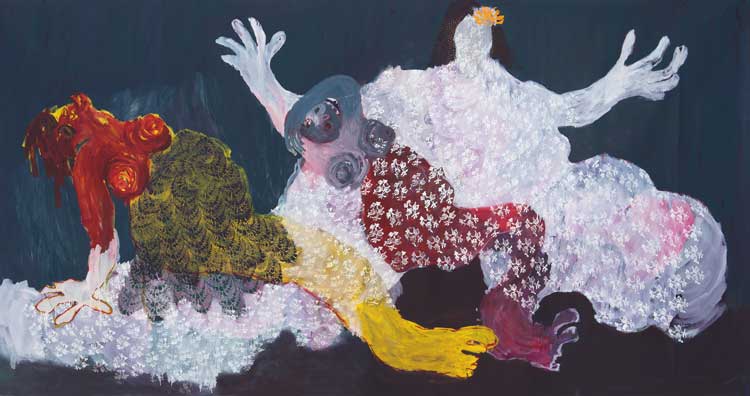
Portia Zvavahera. Embraced and Protected in You, 2016. Oil-based printing ink and oil bar on canvas, 210 x 400 cm. Courtesy Stevenson and David Zwirner. Photo: Mario Todeschini.
In a second gallery space at Kettle’s Yard, we see a collection of works that largely emerged from a single dream. That dream was in fact a nightmare featuring rats, symbolising harm and danger that Zvavahera works to contain to protect herself and her loved ones. Two paintings from 2022 and 2023 engage with this, including Pane Rima Rakakomba (There’s Too Much Darkness) (2023). Six new works made this year continue to explore and develop themes from this same dream. In Zvavahera’s ongoing exploration of the dream, she has filled the space with powerful images on a monumental scale. The gallery space becomes an environment as viewers pass through the dreamscape, mediated by Zvavahera. The scenes themselves are full of horror and hope, both forewarning of trouble and positive prophecies. For me, it is the range of techniques and their curious combinations that is so compelling in these works. This, alongside Zvavahera’s commitment to a unique way of working through dreams, painting and prayer, creates work that is both technically and aesthetically accomplished. This rich and impressive body of work makes for an intense experience, as we encounter the real and the imagined, but never quite know which is which.
• The exhibition will be at Fruitmarket, Edinburgh, from 1 March to 25 May 2025.